Abstract
Our investigation explored the novel findings regarding how high vowel syncope is metrically conditioned in Najdi Arabic (NA), a dialect that is spoken in the Najd province in Saudi Arabia, based on Harmonic Serialism (HS). Our study examined the serial interaction of high vowel syncope and stress/footing, which relies on syllable weight and position in NA. Our findings showed that high vowel syncope in NA occurred in accordance with derivational steps in a feeding order. Moreover, HS is effective for expressing metrically conditioned high vowel syncope in NA.
1 Introduction
In this study, we address metrically-conditioned high vowel syncope based on Harmonic Serialism (HS) with regard to Najdi Arabic (NA), a dialect that is spoken by people who live in the Najd province in Saudi Arabia. Metrically conditioned syncope refers to vowel deletions in metrically weak positions (Faust and Torres-Tamarit 2024; Kaplan 2020; McCarthy 2008). Weak positions, as Kaplan (2020) mentioned, are attributed to unstressed syllables that are dependent within a foot (i.e., dependents) or those that are unparsed, as shown in (1):
| Vowel deletions in weak positions (Kaplan 2020: 584) |
| Weak in foot | (σ́σ) | → | (σ́_) |
| Unparsed | (σσ)σ | → | (σσ)_ |
This process is preceded by building the metrical structure, which conditions it (Faust and Torres-Tamarit 2024, Gouskova 2003; Kager 1997; Kaplan 2020; McCarthy 2008); that is, building the metrical structure pertains to weight assignment and stress/footing.
Syllable weight and position are pivotal in stress placement in NA (Alhammad 2019; Alqahtani 2014; Alshammari 2023). Accordingly, syncope targets a high short vowel in unstressed, non-final open light syllables. Consider the following examples:
| Examples of high vowel syncope in NA (Alqahtani 2014): |
| /b u .ˈsˤa:tˤ/ → | [ˈbsˤa:tˤ] | ‘carpet’ |
| /tu-ˈfu:ħ/ → | [ˈtfu:ħ] | ‘you (m) boil/ she boils’ |
| /tu-ˈθu:r/ → | [ˈtθu:r] | ‘you (m) rage/she rages’ |
| /ð i .ˈra:ʕ/ → | [ˈðra:ʕ] | ‘arm’ |
| /ti-ˈʁa:.mir/ → | [ˈtʁa:.mir] | ‘you (m) take risks’ |
Considering the examples above, one notable question is why the prevalence of high vowel syncope is higher compared to low vowel syncope. This question is cross-linguistically addressed through two approaches. The first approach concerns the correlation of sonority with duration; hence, a vowel with a longer duration is more sonorous than is a vowel with a shorter duration (McCarthy 2007). Therefore, high vowels are subject to deletion rather than low vowels because their duration is shorter than is that of low vowels based on the vowel duration scale (Kirchner 1996; McCarthy 2007); that is, a→i→Ø.[1] The second approach focuses on deleting high vowels due to their sonority value (Howe and Pulleyblank 2004). In other words, high vowels are prone to deletion because they are the least sonorous based on the vowel sonority scale (Howe and Pulleyblank 2004); that is, Low >> Mid >> High. Furthermore, Howe and Pulleyblank (2004) cited a significant number of languages in which less sonorous high vowels were syncopated, such as Canadian French, Bulgarian developed from Proto-Slavic, the native (Yamato) vocabulary of Kagoshima Japanese, Gilbertese, and Yoruba, amongst others. The next section is devoted to previous studies of high vowel syncope in modern Arabic dialects.
2 Previous studies
High vowel syncope is favoured in Arabic dialects because it is weak and is not preferred to surface structures (Alabeeky 2022; Alhammad 2019; Aljutaily and Alhoody 2020; Al-Mohanna 1998; Al Motairi 2015; Al-Mozainy 1981; Alqahtani 2014, 2020; Alshammari 2023; Harrama 1993; Rakhieh 2009; Watson 2002). In Bedouin Hijazi Arabic, the unstressed high vowels in the non-final open light syllables are subject to syncope when these light syllables precede syllables in the forms CVVC or CVCC (Al-Mozainy 1981), as shown in the following examples:
| /ʃu.ˈra:b/ | → | [ˈʃra:b] | ‘leather sack’ |
| /ħu.ˈra:ɡ/ | → | [ˈħra:ɡ] | ‘garbage fire’ |
| /ði.ˈra:ʕ/ | → | [ˈðra:ʕ] | ‘an arm’ |
| /ri.ˈɡa:b/ | → | [ˈrɡa:b] | ‘necks’ |
The precise process is attested in the Al-Jabal dialect in Libya (Harrama 1993); hence, syncope targets an unstressed high short vowel in a non-final, open light syllable followed by a syllable in the form CVVC or CVG (G stands for a geminate). Consider the following examples:
| /ji-ˈɡu:l/ | → | [ˈjɡu:l] | ‘he says’ |
| /ʕu.ˈju:n/ | → | [ˈʕju:n] | ‘eyes’ |
| /ni-ˈɡad.dim/ | → | [ˈnɡad.dim] | ‘I offer’ |
Similarly, Watson (2002) reported that the unstressed high short vowel in non-final open light syllables was liable to syncope if the following syllable was in the form of CVVC in disyllabic words; for example, /hi.ˈribt/→ [ˈhribt] ‘I fled’. Furthermore, in trisyllabic words, the unstressed high short vowel in the light antepenultimate syllable is syncopated if the penultimate syllable is heavy (Watson 2002); for example, /ni-ˈχaz.zin/→ [ˈnχaz.zin] ‘we store’.
Al-Mohanna (1998) stated that an unstressed high short vowel /i/ in a light penultimate syllable, which is derived from the association with a vowel-initial affix, was not exempt from syncope in Urban Hijazi Arabic, as shown in the following examples:
| /ˈkibir-u/ | → | [ˈkib.ru] | ‘they grew up’ |
| /ˈnidim-at/ | → | [ˈnid.mat] | ‘she felt remorse’ |
| /ˈ ʕirif-uh / | → | [ˈʕir.fuh] | ‘he recognised him’ |
In NA, and in Qassim as a sub-dialect, the unstressed high short vowels in non-final open light syllables undergo syncope if the following syllables are in the forms of CVVC and CVCC in disyllabic words and if the following syllables are in the forms of CVC and CVG in trisyllabic words (Alabeeky 2022; Alhammad 2019; Aljutaily and Alhoody 2020; Al Motairi 2015; Alqahtani 2014, 2020; Alshammari 2023).
Conversely, high vowel syncope, which results in non-final CVCC syllables, is blocked in some modern Arabic dialects. For example, Al-Mozainy (1981) presented some examples of Bedouin Hijazi Arabic in which the syncope of an unstressed high short vowel in the light penultimate syllable was blocked to avoid non-final CVCC, as in /jiʃrik-u:n/→[jiʃ.ri.ku:n] /*[jiʃr.ku:n] ‘they become non-believers’ and /jisriɡ-uun/→ [jis.ri.ɡu:n]/*[jisr.ɡu:n] ‘they steal’. Al-Mohanna (1998) added that the syncope of an unstressed high short vowel in the light penultimate syllable was blocked to avoid non-final CVCC, as in /ti-tar.dʒim-uh/ → [ti.tar.dʒ i .muh] / *[ti.tardʒ.muh] ‘she translates it ms.’. Another case in which the syncope of an unstressed high short vowel in a non-final open light syllable is when it is blocked in words in Ma’ani Arabic (Rakhieh 2009) and NA (Alqahtani 2014) that are governed by the phonology of Standard Arabic. Consider the following examples:
| /mu.ˈdi:r/ | → | [mu.ˈdi:r] /*[ˈmdi:r] | ‘manager’ |
| /ˈru.sul-u/ | → | [ˈru.su.lu] / *[ˈrus.lu] | ‘his messengers’ |
However, none of the scholars mentioned above has addressed the serial interaction of stress/footing that is dependent on syllable weight assignment and position, or high vowel syncope in NA in light of OT HS. Therefore, the aim of the current paper is to investigate the serial interaction of high vowel syncope and stress/footing, which relies on syllable weight assignment and position in NA. Two questions are posed to achieve this aim: What derivational steps are responsible for the serial interaction of stress and high vowel syncope in NA? Which OT model is capable of accounting for this serial interaction? The following section presents insights into NA syllable structure by focusing on syllable types, weight (i.e., the moracity of segments), and distribution before stress assignment and footing, as shown in Section 3, since high vowel syncope is conditioned by stress assignment/footing that relies on syllable weight and position.
3 Syllable types, weight, and distribution
The syllable types that are permitted in NA are CV, CVC, CVV, CVVC, CVCC, CCV, CCVC, CCVV, CCVVC, and CCVCC (Abboud 1979; Alabeeky 2022; Alhammad 2019; Alqahtani 2014, 2020; Alshammari 2023; Ingham 1994). These syllables are presented in Table 1.
The syllable types in NA (Alqahtani 2014: 115).
| Syllable types | Example | Translation |
|---|---|---|
| a. CV | [ba. na] | ‘he built’ |
| b. CVC | [maʕ. mal] | ‘nightingale’ |
| c. CVV | [saː. ʕah] | ‘an hour’ |
| d. CVVC | [ra:ħ] | ‘he was gone’ |
| e. CVCC | [bard] | ‘cold’ |
| f. CCV | [nχa. lah]a | ‘a palm tree’ |
| g. CCVC | [msaχ. χin] | ‘you have a fever/he has a fever’ |
| h. CCVV | [zba:. lah] | ‘trash’ |
| i. CCVVC | [ɡbu:r] | ‘graves’ |
| j. CCVCC | [smint] | ‘cement’ |
-
aThis word-initial cluster in NA is formed by CV metathesis (Abboud 1979; Alqahtani 2014; Al-Solami 2013; Blanc 1970; Blevins and Garrett 1998; Ingham 1994; Zawaydeh 1999), which is outside of the scope of this paper.
According to the NA syllable types in Table 1 above, simple onsets are mandatory, whereas complex onsets are optional. Unlike onsets, both simple and complex codas are optional. This is evident based on some syllable types that have onsets and lack codas, such as CV, CVV, CCV, and CCVV. Similarly, complex onsets are optional since they are absent from some syllable types and are found in others, such as CCV, CCVC, CCVV, CCVVC, and CCVCC. Considering the syllable weight, the NA syllable types listed above can also be distinguished by their weight. For instance, light syllables CV and CCV are underlyingly monomoraic (i.e., a short vowel in both syllable types has one mora) (Hayes 1989, 1995). Consider the following representation [ba. na] ‘he built’ and [nχa.lah] ‘a palm tree’:
| CV |
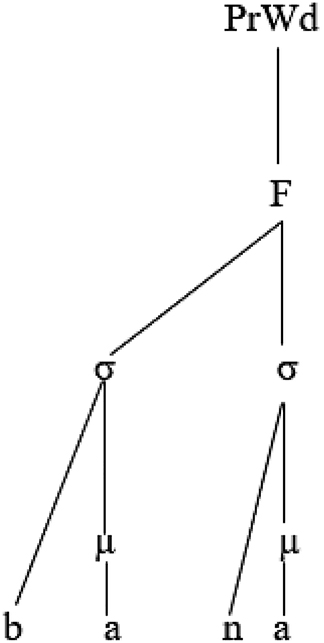
|
| CCV |
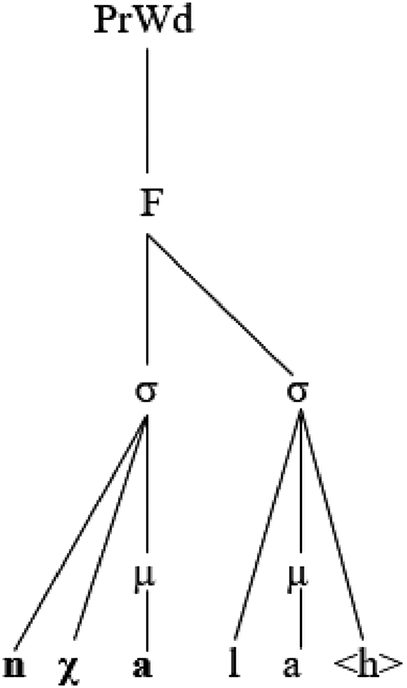
|
However, the distinction between these light syllables is specific to their position. CV is a monomoraic syllable in the initial, medial, and final positions, while CCV, as a monomoraic syllable, is restricted to the initial position (Alqahtani 2014; Alshammari 2023). CVV is a heavy syllable in which the long vowel is underlyingly bimoraic (Hayes 1989, 1995), as shown in the following representation of [saː. ʕah] ‘an hour’.
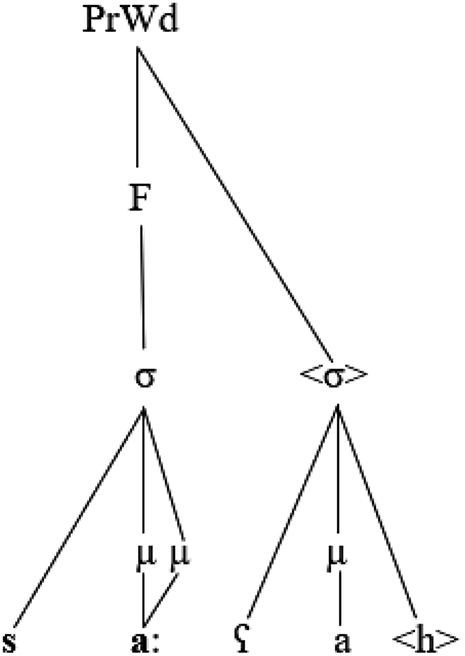
CVV is confined to the initial and medial position. Conversely, no restriction is imposed on the position of CVC; the weight of this syllable is heavy in the non-final position, which is either the initial or the medial position, due to weight-by-position (WBP) (Alqahtani 2014; Alshammari 2023; Hayes 1989).[2] However, CVC in the final position fails to attract stress and is light due to extrametricality.[3]
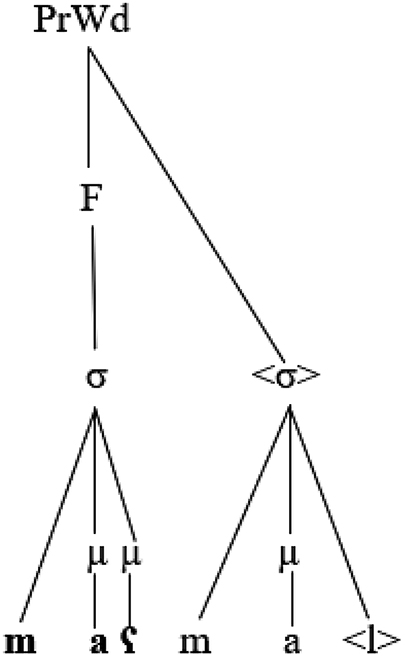
CVVC is found as a heavy syllable in the initial and medial positions through mora sharing to affiliate a semisyllable (i.e., a moraic segment) to the syllable node; otherwise, it would violate the ban on trimoraic syllables (Alqahtani 2014; Alshammari 2023; Watson 2007). Kiparsky (2003) presented the characteristic cross-linguistic properties of semisyllables as follows:
| The characteristic cross-linguistic properties of semisyllables (Kiparsky 2003: 156): |
| Unstressed, toneless, or reduced tonal contrasts. |
| Restricted segmental inventory. |
| Can be less sonorous than syllable nuclei. |
| Restricted shape (e.g., no onset, or no branching onset, or no coda). |
| Sometimes restricted to a peripheral position (typically word edge). |
| Prosodically invisible. |
| Can be subject to a minimum sonority requirement. |
Kiparsky (2003) posited that a semisyllable skipped the syllable node and was linked directly to the prosodic word, as shown in the representation below:

A semisyllable in the representation (11) violates the Strict Layer Hypothesis (SLH). To demonstrate the SLH, it is essential to illustrate the prosodic hierarchy and to then indicate the SLH to show how a semisyllable in the above representation is a mismatch with the SLH. Selkirk (1984, 2011), Nespor and Vogel (1986), and Roca (1994) unanimously agreed that prosodic hierarchy was an ordered set of prosodic category types. Selkirk (2011: 437) added that “these prosodic categories constitute possible node labels for prosodic structures and in the standard view are stipulated by phonological theory”. Consider the following prosodic hierarchy:
| Prosodic hierarchy (Roca 1994: 195): |
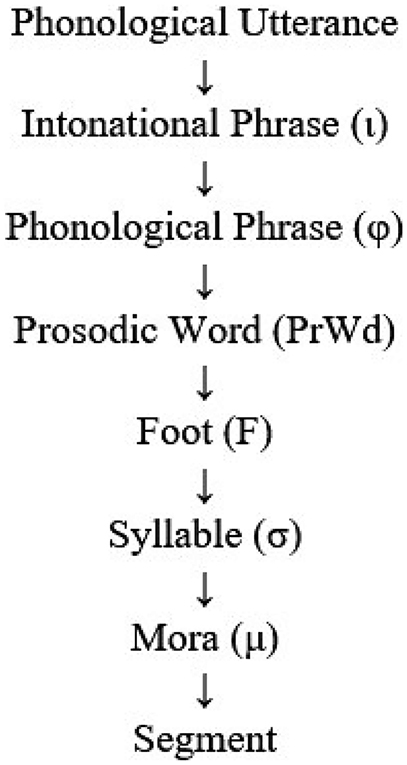
|
The SLH, a fundamental and widely recognised concept in linguistics, is a term that is used to encapsulate the idea that a prosodic constituent structure is meticulously organised based on the ordered set of prosodic category types in the prosodic hierarchy shown above (Itô 1986; Nespor and Vogel 1986; Selkirk 1984, 2011). Rakhieh (2009: 175) emphasised the importance of the SLH by stating that it “demands that every non-highest prosodic element be in its entirety a constituent belonging to the next highest category on the prosodic hierarchy”. In the context of the representation in (10) above, a semisyllable violates the SLH due to the directed link to the prosodic word. Alqahtani (2014) pointed out that a semisyllable above was not linked to a syllable or to a foot. Kiparsky (2003) and Watson (2007) proposed two solutions to link a semisyllable above to a syllable node, namely vowel epenthesis and mora sharing. Alqahtani (2014) suggested that a semisyllable found in a non-final CVVC could be affiliated to the syllable node via mora sharing to conform to the ban on trimoraic syllables and the SLH. Consider the following representation:
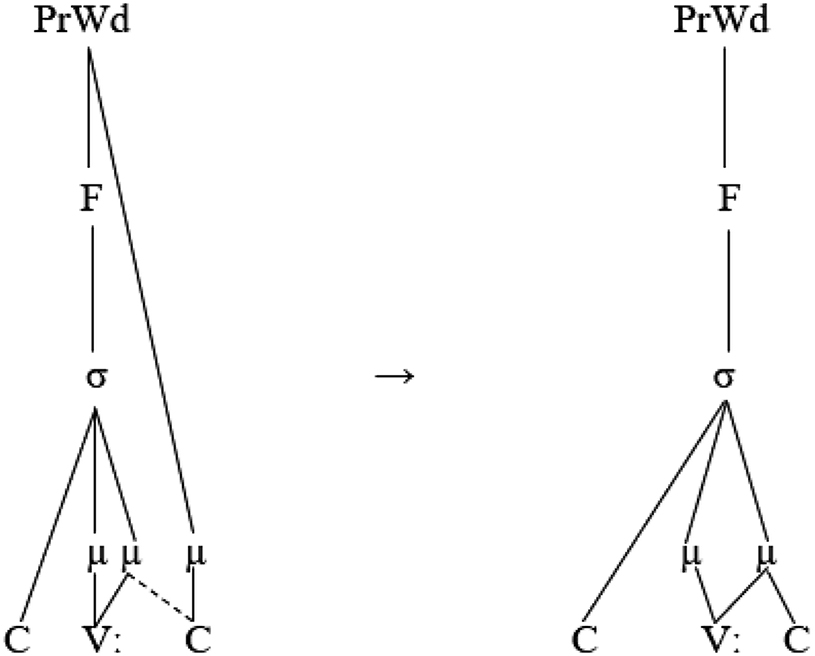
The following representation of the output [baːµµb. naµ] ‘our door’ shows how mora sharing serves to affiliate a semisyllable to the syllable node:
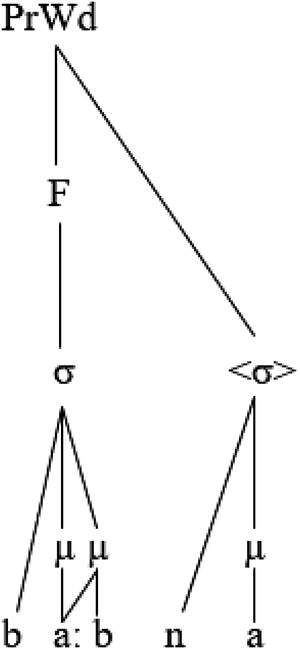
However, mora sharing does not apply to CVVC and CVCC in the final position (Alqahtani 2014). The coda in final CVVC and CVCC is treated as extrasyllabic because it is not within the syllabic domain; that is, it is peripheral (Hayes 1995; Kager 1995; Kenstowicz 1994; Kiparsky 2003).[4] Consider the representation of [raːµµ. ħ] ‘he was gone’ and [baµrµ.d] ‘cold’.
| [raːµµ. ħ] ‘he was gone’ |
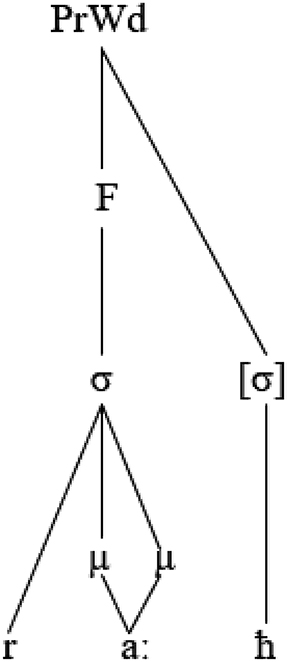
|
| [baµrµ.d] ‘cold’ |

|
The CVCC syllable is limited to the final position if the word-final cluster adheres to the crucial sonority sequencing principle (SSP). If not, the word-final cluster is split by vowel epenthesis (Alqahtani 2014). In addition, the non-final CVCC is avoided by vowel epenthesis rather than by mora sharing to affiliate a semisyllable to a syllable node (Alqahtani 2014; Alshammari 2023), as demonstrated in the representation of the output [ˈbiµnµ.t i µ.haµ] ‘her daughter’:
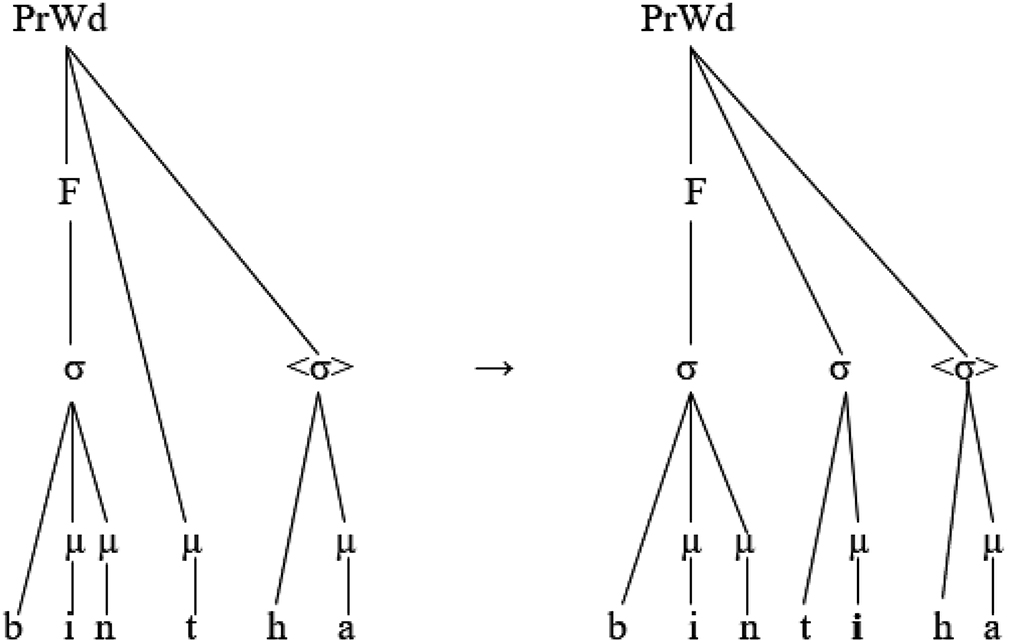
CCVC, CCVV, CCVVC, and CCVCC are derived from deleting the unstressed high short vowels in the non-final open light syllables (Alqahtani 2014; Alshammari 2023). CCVC and CCVV are restricted to non-final positions in disyllabic words, while CCVVC and CCVCC are only found in monosyllabic words (Alqahtani 2014; Alshammari 2023). Consider the following representations:
| CCVC, e.g. [ˈmsaµχµ. χiµn] ‘you have a fever/he has a fever’ |

|
| CCVV, e.g., [ˈzba:µµ.laµh] ‘good news’ |
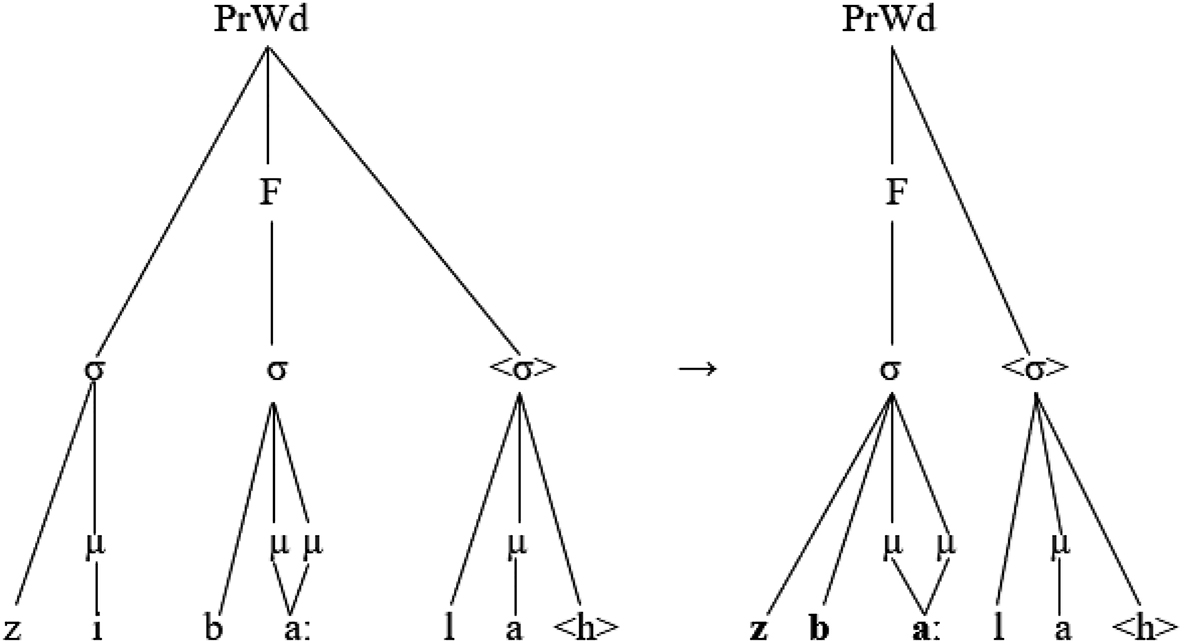
|
| CCVVC, e.g., [ɡbu:µµ.r] ‘graves’ |

|
| CCVCC, e.g., [ˈsmiµnµ.t] ‘cement’ |
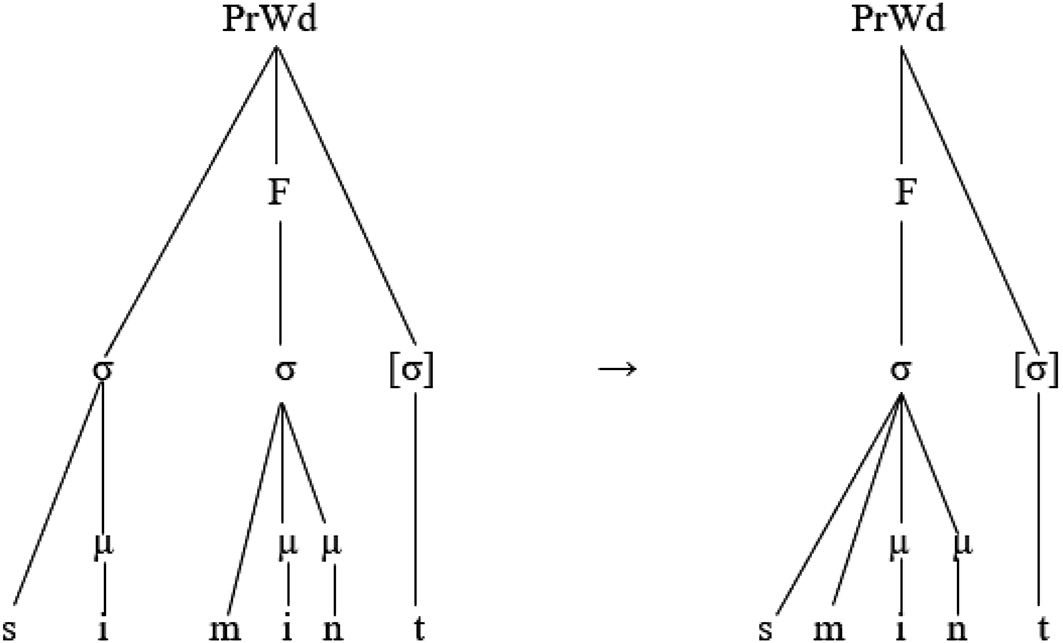
|
In summary, we revealed the complex nature of the NA syllable structure in this section, and delved into syllable types, weight (i.e., the moracity of segments), and position. CV is a light syllable (i.e., underlyingly monomoraic) in NA regardless of its position; hence, it can be found in the initial, medial, and final positions. It is unstressed in the final position or follows a heavy syllable. Conversely, it can be stressed in the non-final position if it precedes the final CVC, in which the final C is assigned as being extrametrical. CVV is found as a stressed heavy syllable in the non-final position since a long vowel is underlyingly bimoraic. However, CVC is found to be a heavy syllable in the non-final position due to WBP in comparison to the final position. CVVC is treated as a heavy syllable in the non-final position; hence, a semisyllable, as a moraic consonant, is affiliated to the syllable node by mora sharing to conform to the ban on trimoraic syllables and SLH. Mora sharing is not applied to the same syllable in the final position because its coda is assigned as extrasyllabic; nonetheless, it is still heavy. CVCC is blocked in the non-final position through vowel epenthesis rather than via mora sharing to obey the ban on trimoraic syllables and SLH. By contrast, CVCC is found in the final position as a heavy syllable because its last consonant is assigned as being extrasyllabic. CCV, which is the result of CV metathesis, is only seen as a stressed light syllable in the non-final position if the following syllable is light.[5] It is interesting that the syllables types in the forms CCVC, CCVV, CCVVC, and CCVCC result from the syncope of the unstressed high short vowels in non-final open light syllables; hence, this phonological process mainly relies on syllable weight assignment and stress assignment/footing. NA syllable weight was demonstrated in this section, while stress assignment/footing in the same variety will be discussed in the next section.
4 Stress assignment and footing
NA has a quantity-sensitive stress system in which syllable weight and position determine the location of the potentially stressed syllable within content words (Alhammad 2019; Alqahtani 2014; Alshammari 2023). Specifically, NA stress parameters are predictable (i.e., non-phonemic); therefore, stress assignment is rule-governed (Alshammari 2023). Of note, one of the last three syllables in a word from the right edge, such as the ultimate, penultimate, and antepenultimate, receives the primary stress, whereas the preantepenultimate never attracts stress (Alhammad 2019; Al Motairi 2015; Alqahtani 2014; Alshammari 2023; Ingham 1994). As discussed in the previous section, the number of moras measures syllable weight in NA. Alqahtani (2014) and Alshammari (2023) agreed that syllable weight in NA was divided into light, assigning a single mora (i.e., monomoraic), heavy, assigning two moras (i.e., bimoraic), and superheavy, assigning two moras plus an extrasyllabic consonant (cf. Watson 1999, 2002, 2011), following moraic theory (Davis 2011; Hayes 1989, 1995; Hyman 1985). Coda consonants are assigned one mora through WBP in a non-final position, whereas geminates are always moraic (Alqahtani 2014; Alshammari 2023). Conversely, the final CVC in NA is light and thus fails to attract stress (Alqahtani 2014; Alshammari 2023). Onsets in NA are weightless and do not affect stress assignments (Alqahtani 2014; Alshammari 2023). Consider the following stress parameters to understand NA stress assignment:
| NA stress parameters (Alhammad 2019; Al Motairi 2015; Alqahtani 2014; Alshammari 2023; Ingham 1994) |
| The ultimate heavy syllables in the forms CVVC and CVCC receive stress. |
| CV. (ˈCVV).C, e.g., ʕa. (ˈsˤiː).r | ‘juice’ |
| CV. (ˈCVC).C, e.g., da. (ˈras).t | ‘I/you sg. ms. learnt’ |
| Otherwise, stress is received by the heavy penultimate syllables of CVV and CVC forms. |
| CV. (ˈCVV). CVC, e.g., ma. (ˈkaː). tib | ‘offices’ |
| (ˈCVC). CVC, e.g., (ˈmak).tab | ‘office’ |
| Stress falls on the penultimate syllable if the ultimate syllable is neither CVVC nor CVCC in disyllabic words. |
| (ˈCVC).CV, e.g., (ˈbin).ti | ‘my daughter’ |
| If the penultimate syllable is not heavy and the ultimate syllable is neither CVVC nor CVCC, stress is received by the antepenultimate syllable. |
| (ˈCV.CV).CV, e.g., (ˈda. ra). sat | ‘she learnt’ |
| (ˈCVC). CV.CVC, e.g., (ˈmitˤ).ra. ɡah | ‘hammer’ |
| The preantepenultimate syllable never receives stress |
| Geminated consonants do not generally occur in the final syllable in disyllabic words in NA. As a result, geminates undergo degemination and the stress is received by the preceding syllable (regression of stress), as in /ji. ˈmidd/→ degemination→ [ˈji. mid] ‘he spreads’ |
The NA stress parameters presented above show that stress assignment and footing are simultaneous. In turn, this would lead us to demonstrate the concept of footing and how the foot is constructed in NA. The term foot is attributed to the grouping of syllables, including the head. The most binary feet are trochee and iambic; hence, the first syllable is prominent in a trochaic foot and vice versa in an iambic foot. Other types of feet are bounded and unbounded based on foot size. The size of bounded feet is fixed regarding syllables and moras, in contrast to the size of unbounded feet. Hayes (1995) presented different foot types in bounded feet languages; as follows:
| Foot types (Hayes 1995) |
| Syllabic Trochee | (ˈσ σ) |
| Moraic Trochee | (ˈµ µ) | (ˈLL) |
| (ˈH) |
| Iamb | (σ ˈσ) | (LˈL) |
| (LˈH) | ||
| or | ||
| (ˈσ) | (ˈH) |
With regard to the foot types shown above, the syllabic trochee has two syllables in every foot, in which the first is accented. The feet in this type have two light syllables, a heavy plus a light syllable, or two heavy syllables. In the moraic trochee, every foot has two moras, exemplified by two light syllables or one heavy syllable; hence, the first syllable is the head. Every iambic foot has two syllables (i.e., two light syllables or a light plus a heavy syllable); the second is the head or one syllable (i.e., a heavy syllable).
The foot type in NA is a moraic trochee that is left-headed and binary, and its directionality is from left to right (Alshammari 2023). (ˈLL) and (ˈH), as Alshammari (2023) reported, form the foot inventory in NA; Alshammari accounted for the stress system in NA by using certain parameters and the rules for foot construction that Hayes (1995) proposed when accounting for the stress system in other Arabic dialects such as Negev Bedouin, Palestinian, and Egyptian Arabic. The directionality of foot parsing in NA is from left to right, in line with the effect of End Rule Right (ERR) (Alshammari 2023). Feet in a moraic or syllabic analysis are binary (Alshammari 2023). A degenerate foot is prohibited in NA since unparsed monomoraic syllables are invisible to stress rules and fail to form a foot independently (Alshammari 2023).[6] The former statement was supported by Hayes (1995), who pointed out the strong correlation between the size of the minimal word and the treatment of degenerate feet: A language is unlikely to permit a degenerate foot if it does not allow minimal words that are smaller than its proper foot. Moreover, the ERR is pivotal in prohibiting degenerate feet because it assigns stress to the right-most foot in a given word. Alshammari (2023) indicated that the directionality of footing influenced stress assignment in NA; his indication raises two questions about the directionality of footing when encountering an odd number of light syllables, such as right to left or left to right, and regarding the treatment of unparsed light syllables after footing construction. These questions were answered by Alshammari (2023), who examined the footing construction of the example [ˈħa.ʃa.ra<h>] ‘inset’, which contains three light syllables, as shown in the following representation. Bearing in mind that parentheses ( ) mark a foot, the (x) symbol marks the stressed elements, the bullet (•) marks the unstressed elements, the angled brackets < > mark the extrametrical element, a breve (˘) marks a monomoraic syllable, and the macron (¯) marks a bimoraic syllable.
| LLL→(ˈLL)L (Alshammari 2023:197) | ||||
| ( x | ) | Prosodic Word Level (ERR) | ||
| ( x | •) | Foot Level | ||
| ˘ | ˘ | ˘ | Moraic Level | |
| ħ a | ʃ a | r | a <h> | Segmental Level |
Based on the representation above, Alshammari (2023) showed that the directionality of footing was from left to right, yielding a disyllabic foot of two light syllables with a trochaic stress: (ˈħa.ʃa). By contrast, the ultimate syllable with the last extrametrical consonant is unparsed in the preceding foot construction at the foot level because it is unstressed and monomoraic, as well as because of a ban on a degenerative foot based on ERR (Alshammari 2023). The notion of consonant extrametricality paves the way for demonstrating a strong correlation between the size of the minimal word and the treatment of degenerate feet, as Hayes (1995) mentioned. To clarify, let us assume that the directionality of foot parsing is the opposite, or right to left: The ultimate syllable would be [ra] footed with the preceding syllable [ʃa], and the unparsed syllable would consequently receive stress *(ʃa. ˈra<h>) (Alshammari 2023). The extrametricality assignment to the final consonant in the ultimate syllable in (20) matches the extrametricality conditions that Hayes (1995: 57–58) introduced:
| Constituency | Only constituents (segments, syllables, foot, phonological word, affix) may be marked as extrametrical. |
| Peripherality | A constituent may be extrametrical only if it is at a designated edge (left or right) of its domain. |
| Edge Markedness | The unmarked edge for extrametricality is the right edge. |
| Nonexhaustivity | An extrametricality rule is blocked if it would render the entire domain of stress rules extrametrical. |
The same behaviour is attested in Ma’ani Arabic (Rakhieh 2009) when considering the footing construction of the example [ˈʃa.ʤa.ra<h>] ‘a tree’; hence, the directionality of footing is from left to right, having the same result as in NA, and the final syllable is not parsed with the preceding foot construction for the same reasons that were mentioned previously. The question that some scholars have asked is whether a foot can be extrametrical. Based on the conditions above, the extrametricality of final feet is attested in Ma’ani Arabic (Rakhieh 2009) and in NA (Alshammari 2023). For instance, the trisyllabic word maktabah ‘library’ has the stress on the antepenultimate syllable since it is heavy, or bimoraic, as shown in (22): the final foot extrametricality stipulates the primary stress assignment to the antepenultimate syllable, as the ERR principle governs stress.
| ( x | ) | Prosodic Word Level (ERR) | |
| (x) | < (x | •)> | Foot Level |
| - | ˘ | ˘ | Moraic Level |
| mak | t a | b a <h> | Segmental Level |
The representation above reveals two points that Rakhieh (2009) and Alshammari (2023) discussed, despite the differences in the Arabic dialects being considered. The first point is that foot extrametricality is not blocked by the extrametrical consonant of the ultimate syllable because the extrametrical consonant is in the peripheral foot and does not split the foot from the right edge (Hayes 1995; Watson 2002). This is also the case in Palestinian and Bani-Hassan dialects of Arabic (Hayes 1995). Accordingly, the antepenultimate syllable is stressed by consonant and foot extrametricality (Alshammari 2023; Hayes 1995; Rakhieh 2009; Watson 2002). The second point is peculiar to the nonexhaustivity condition above, in which foot extrametricality is blocked if the peripheral foot is the only foot in the word; otherwise, the entire domain of stress rules would be exhausted by extrametricality. Consider the foot in the word rasam ‘he wrote’, which is exempt from extrametricality, as shown in the following representation:
| ( x | ) | Prosodic Word Level (ERR) |
| ( x | •) | Foot Level |
| ˘ | ˘ | Moraic Level |
| r a | s a <m> | Segmental Level |
In the representations above, as well as in (20) and (22), the last consonant in the ultimate syllable CVC is assigned as extrametrical since it fails to assign mora through the weight-by-position (WBP) (Hayes 1989, 1995) rule and meets the peripherality condition above, which limits the occurrence of extrametricality to the edges of constituents (Alqahtani 2014; Alshammari 2023). This statement was supported by Clements (1990: 299) and Watson (2002: 63), who mentioned that consonant extrametricality preceded the assignment of the mora through WBP as long as syllabification was achieved regarding the following algorithm:
| Consonant extrametricality : C > ⟨C⟩/______ ]word. |
| Associate moraic segments to a syllable node. |
| Given P (an unsyllabified segment) preceding Q (a syllabified segment), adjoin P to the syllable containing Q if P has a lower sonority rank than Q (iterative). |
| Given Q (a syllabified segment) followed by R (an unsyllabified segment), assign a mora to R (WBP) [if R has a lower sonority rank than Q (iterative)]. |
| Adjoin moraic R to the syllable containing Q (iterative). |
Alqahtani (2014: 45) stated that the above algorithm could be exemplified in the syllabification of the word maʕmal ‘lab’ in NA, as shown below:
| final consonant extrametricality |
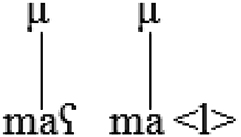
|
| Association of moraic segments to a syllable node |
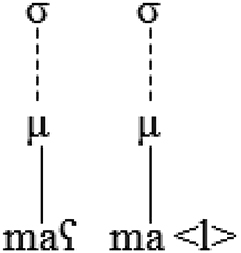
|
| Association of onset to syllable node |
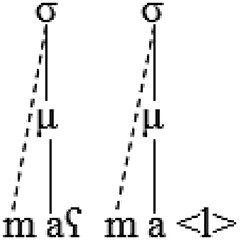
|
| Assignment of mora through WBP |
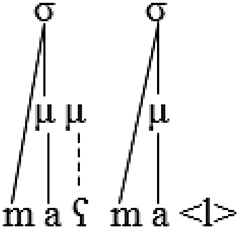
|
| adjunction of WBP mora to syllable node |

|
| incorporation of extrametrical consonant into preceding syllable |
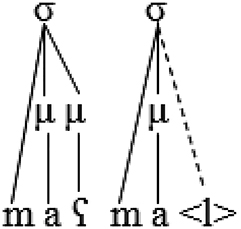
|
By contrast, the notion of extrametricality does not apply to the stressed ultimate syllables of the forms CVVC and CVCC; hence, their last consonant is deemed extrasyllabic and is undominated by a mora or a foot as a higher constituent (Alqahtani 2014; Alshammari 2023). Extrasyllabic consonants in CVVC and CVCC syllables fall outside of the syllable domain (Hayes 1995; Kager 1995; Kenstowicz 1994; Kiparsky 2003). Consider the following representation:
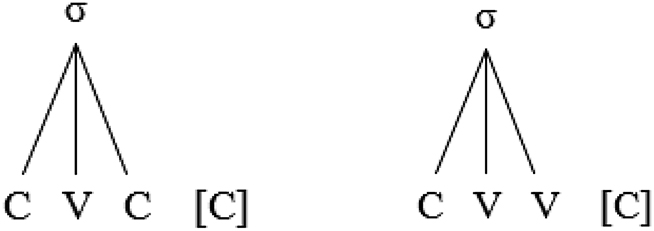
An extrasyllabic consonant, as both Aoun (1979) and Selkirk (1981) reported, is directly linked to a degenerate syllable, as shown in the following representation:

It is important to note that foot extrametricality does not align with extrasyllabicity. The application of foot extrametricality is revoked by extrasyllabic segments, which are shown between the foot and the right-most edge, violating the peripherality condition (Hayes 1995: 106). However, the notion of extrasyllabicity plays a crucial role in banning trimoraic syllables in Arabic varieties, mainly when encountering CVVC and CVCC in the final position (Alabeeky 2022; Alhammad 2019; Aljutaily and Alhoody 2020; Al Motairi 2015; Alqahtani 2014; Alshammari 2023; Aoun 1979; Hayes 1995; Kager 1995; Kenstowicz 1994; Kiparsky 2003; Rakhieh 2009; Selkirk 1981; Watson 2002). Consider the following representations of [laµ. (ˈʕaµbµ)t] ‘I/ you played’ and [ba.(ˈnaː)t] ‘girls’.[7]
| [laµ. (ˈʕaµbµ)t] ‘I/ you played’ |

|
| [ba.(ˈnaː)t] ‘girls’ |
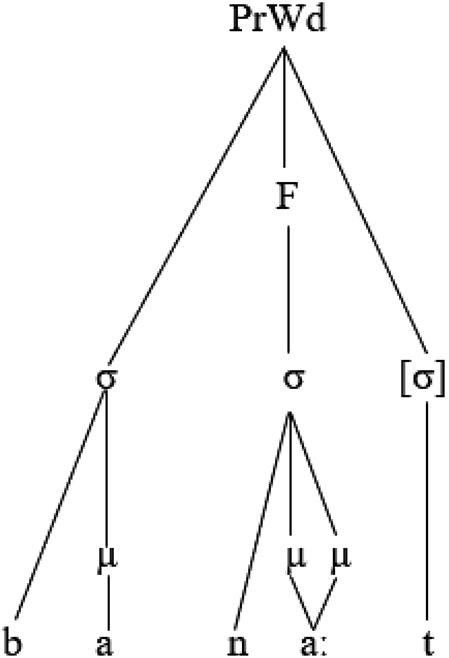
|
Having established the NA stress assignment/footing with regard to syllable weight and position, the following section presents the comprehensive data collection and an analysis using the HS-OT framework. Furthermore, the serial steps of high vowel syncope in NA are presented and explained in detail using the HS-OT framework to ensure a thorough understanding.
5 Data collection and analysis
The research methodology in our study encompassed three primary steps. First, the study was mainly based on data obtained from the existing literature, including books, articles, and theses. Second, the author’s judgements as a native speaker of NA were used to verify the data. Third, the author sought the input of ten male native speakers of NA to validate the observations regarding the NA data to ensure that the study’s findings are robust and reliable.
High vowel syncope targets unstressed high short vowels in non-final open light syllables followed by CVVC and CVCC syllables in disyllabic words, as in (29-I, III). In trisyllabic words, the unstressed high short vowels in the light antepenultimate syllables undergo syncope if the penultimate syllable is heavy (i.e., bimoraic), as in (29-II). Consider the following examples:
| a. | /tuµraːµµb/→ | /tuµ. raːµµ. b/→ | /tuµ. (ˈraːµµ). b/→ | [(ˈtraːµµ). b] | ‘dust’ |
| b. | /ʤiµbaːµµl/→ | /ʤiµ. baːµµ. l/→ | /ʤiµ. (ˈbaːµµ). l/→ | [(ˈʤ baːµµ). l] | ‘mountains’ |
| c. | /kiµtaːµµb/→ | /kiµ. taːµµ. b/→ | /kiµ. (ˈtaːµµ). b/→ | [(ˈktaːµµ). b] | ‘book’ |
| d. | /ðiµraːµµʕ/→ | /ðiµ. raːµµ. ʕ/→ | /ðiµ. (ˈraːµµ). ʕ/→ | [(ˈðraːµµ). ʕ] | ‘an arm’ |
| e. | /siµlaːµµħ/→ | /siµ. laːµµ. ħ/→ | /siµ. (ˈlaːµµ). ħ/→ | [(ˈslaːµµ). ħ] | ‘a weapon’ |
| f. | /zuµluːµµf/→ | /zuµ. luːµµ. f/→ | /zuµ. (ˈluːµµ). f/→ | [(ˈzluːµµ). f] | ‘sideburns’ |
| g. | /fuµluːµµs/→ | /fuµ. luːµµ. s/→ | /fuµ.(ˈluːµµ).s/→ | [(ˈfluːµµ). s] | ‘money’ |
| h. | /ħiµbaːµµl/→ | /ħiµ. baːµµ. l/→ | /ħiµ.(ˈbaːµµ).l/→ | [(ˈħbaːµµ). l] | ‘ropes’ |
| i. | /ʕiµnaːµµd/→ | /ʕiµ. naːµµ. d/→ | /ʕiµ.(ˈnaːµµ).d/→ | [(ˈʕnaːµµ). d] | ‘stubbornness’ |
| j. | /huµnuːµµd/→ | /huµ. nuːµµ. d/→ | /huµ.(ˈnuːµµ).d/→ | [(ˈhnuːµµ). d] | ‘Indians’ |
| k. | /huµmuːµµm/→ | /huµ. muːµµ.m/→ | /huµ.(ˈmuːµµ).m/→ | [(ˈhmuːµµ).m] | ‘concerns (n.)’ |
| l. | /ɡuµruːµµd/→ | /ɡuµ. ruːµµ. d/→ | /ɡuµ.(ˈruːµµ).d/→ | [(ˈɡruːµµ). d] | ‘monkeys’ |
| m. | /kiµlaːµµb/→ | /kiµ. laːµµ. b/→ | /kiµ.(ˈlaːµµ).b/→ | [(ˈklaːµµ). b] | ‘dogs’ |
| n. | /ɡuµruːµµʃ /→ | /ɡuµ. ruːµµ. ʃ /→ | /ɡuµ.(ˈruːµµ). ʃ/→ | [(ˈɡruːµµ). ʃ] | ‘coins’ |
| o. | /kuµfuːµµf /→ | /kuµ. fuːµµ. f /→ | /kuµ.(ˈfuːµµ). f/→ | [(ˈkfuːµµ). f] | ‘palms’ |
| p. | /ruµ.fuːµµ.f /→ | /ruµ. fuːµµ. f /→ | /ruµ. (ˈfuːµµ). f/→ | [(ˈrfuːµµ). f] | ‘shelves’ |
| a. | /siµmiµnt/→ | /siµ.miµn.t/→ | /siµ.miµnµ.t/→ | /siµ.(ˈmiµnµ).t/→ | [(ˈsmiµnµ).t] | ‘cement’ |
| b. | /kiµtaµbt/→ | /kiµ. taµb.t/→ | /kiµ. taµbµ.t/→ | /kiµ.(ˈtaµbµ).t/→ | [(ˈktaµbµ).t] | ‘I/you wrote’ |
| a. | /ziµraːµµʕaµh/→ | /ziµ. raːµµ. ʕaµ<h>/→ | /ziµ. (ˈraːµµ).ʕaµ<h>/→ | [(ˈzraːµµ). ʕaµ<h>] | ‘agriculture’ |
| b. | /tiµʁaːµµmiµr/→ | /tiµ. ʁaːµµ.miµ<r>/→ | /tiµ. (ˈʁaːµµ).miµ<r>/→ | [(ˈtʁaːµµ). miµ<r>] | ‘you (ms.) take risks’ |
| c. | /tiµmaµθːµiµl/→ | /tiµ.maµθµ. θiµ<l>/→ | /tiµ. (ˈmaµθµ). θiµ<l>/→ | [(ˈtmaµθµ). θiµ<l>] | ‘you act, or he/she acts’ |
With regard to the examples in (29), unstressed high short vowels in non-final open light syllables undergo syncope. For instance, in (29-I), vowel syncope targets unstressed high vowels in non-final open light syllables that precede the stressed ultimate syllables in the form of CVVC. Similarly, in (29-II), the unstressed high short vowel in the light penultimate syllable is not immune to syncope when the following syllable, which is the ultimate syllable, is in the form of CVCC. The unstressed high short vowels in the antepenultimate syllables in (29-III) are subject to syncope when these syllables are followed by heavy syllables that include either the first halves of geminates or stressed syllables in the form of CVV. The same high vowel syncope rules are attested in Wadi Ramm Arabic (Mashaqba 2015). However, the difference is that the vowel [a] in non-final light syllables undergoes syncope in Wadi Ramm Arabic, as in /laha/→[lha] ‘her’.
The above examples also show that high vowel syncope in NA is derivational since it is conditioned by stress assignment/footing that, in turn, is dependent on syllable weight (i.e., mora assignment) and position. For instance, the high vowel syncope in (29-I, II) is achieved via three derivational steps. The first step is syllabification, assigning the last C as extrasyllabic to avoid the violation of the WBP. Remember that vowels and geminates are underlyingly moraic, as discussed in Sections 3 and 4. The second step is stress assignment/footing, which facilitates the implementation of syncope that targets an unstressed high short vowel in the non-final open light syllable as the final step. In this case, high vowel syncope is a transparent rule interaction known as “feeding”, in which the first step prepares an environment for the second step to be applied which, in turn, facilitates the application of syncope as the final step. This feeding order is outlined below:
| Underlying representation | /tuµraːµµb/ ‘dust’ |
| Syllabification | tuµ. raːµµ. b |
| Stress assignment/footing | tuµ. (ˈraːµµ). b |
| Syncope | (ˈtraːµµ). b |
| Surface | [(ˈtraːµµ). b] |
The same derivational steps run high vowel syncope (29, II) in the same feeding. The first step is syllabification, assigning the last C as extrametrical, as discussed in the algorithm in (24). The second step is stress assignment/footing, and syncope is the final step (i.e., Rule 3). This feeding order is outlined below:
| Underlying representation | /ziµraːµµʕaµh/ ‘agriculture’ |
| Syllabification | /ziµ. raːµµ. ʕaµ<h>/ |
| Stress assignment/footing | /ziµ. (ˈraːµµ).ʕaµ<h>/ |
| Syncope | (ˈzraːµµ). ʕaµ<h> |
| Surface | [(ˈzraːµµ). ʕaµ<h>] |
The feeding orders presented above show that syllabification, stress assignment/footing, and syncope do not occur simultaneously and require more than two levels to be expressed. In other words, metrical structure assignment and syncope do not co-occur; hence, they run serially (i.e., gradualness). This statement was supported by McCarthy (2008), who stated that building the metrical structure and the syncope were sequential. Therefore, intermediate levels between the input and output are necessary to express them. The feeding order in (31) and (32) is accounted for using classic OT (parallel OT). Before delving into the parallel OT analysis, consider the list of the OT constraints.
| List OT constraints: |
| Nonfinality (Prince and Smolensky 1993) |
| No head of PrWd is final in PrWd. |
| Foot Binarity (Ft-Bin) (Prince and Smolensky 1993) |
| Feet are binary at some level of moraic or syllabic analysis. |
| Parse-Syl (Prince and Smolensky 1993) |
| All syllables must be parsed into feet in a prosodic word. |
| *Final-cµ (Hayes 1989) |
| Word-final coda consonants are weightless. |
| WBP (Hayes 1989) |
| Assign a violation for each coda consonant that is not moraic. |
| Weight-To-Stress-Principle (WSP) (McCarthy and Prince 1995) |
| Heavy syllables are prominent both on the grid and foot structure. |
| *ComplexONS (Prince and Smolensky 1993) |
| A syllable must not have more than one onset segment. |
| Max (McCarthy and Prince 1995) |
| Assign a violation for each segment in the input that is not present in the output (no deletion). |
| GrWd = PrWd (Kager 1999). |
| A grammatical word must be a prosodic word. |
With regard to the list of OT constraints presented above, GrWd = PrWd, WSP, and WBP must outrank the remainder of the constraints to ensure syllabification and stress assignment/footing. *Final-cµ, as the second highly ranked constraint, acts against non-moraic coda. Nonfinality, another highly ranked constraint, ensures that a foot that is obligated by the GrWd = PrWd must not be the final foot in the prosodic word to conform to Ft-Bin as the following constraint. Parse-Syl is used to parse syllables within feet in a prosodic word. The next is *ComplexONS, which bans candidates that have complex onsets. Max, as the least-ranked constraint, is against the deletion of segments. Consider the following set of OT constraints:
| GrWd=PrWd, WSP, WBP>>*Final-cµ>>Nonfinality>>Ft-Bin>>Parse-Syl>> *ComplexONS>>Max |
The above set of OT constraints is used in the following parallel OT analysis of the candidates for the input /tuµraːµµb/ ‘dust’ in the Tableau 1.
/tuµraːµµb/→[(ˈtraːµµ). b].
| /tuµraːµµb/ | GrWd = PrWd | WSP | WBP | *Final-cµ | Nonfinality | Ft-Bin | Parse-Syl | *ComplexONS | Max |
|---|---|---|---|---|---|---|---|---|---|
| a. tuµ. raːµµb | *! | * | * | ** | |||||
| b. tuµ. raːµµ. b | *! | * | ** | ||||||
| c. tuµ. raːµµbµ | *! | * | * | ** | |||||
| d. tuµ. (ˈraːµµ). b | *! | ||||||||
e.  (ˈtraːµµ). b (ˈtraːµµ). b |
* | * | |||||||
| f. tuµ. (ˈraːµµbµ) | *! | * | * | * |
Candidate (e) emerges as the optimal output because it avoids the violation of GrWd = PrWd, Final-cµ, and Parse-Syl. However, these constraints are subject to fatal violation by the rest of candidates, and are eliminated as a result.
Parallel OT is not immune from criticism; nonetheless, it shows candidate (e) as being optimal in the above tableau. Classic OT cannot express the feeding order in (28) and (29) since it is focused on input-output mapping without considering the intermediate levels between the input and the output (McCarthy 2008, 2016). The serial derivation with stress before the syncope could be accounted for using stratal OT. However, metrical structure assignment and syncope could occur simultaneously within a single stratum because each stratum is a classic OT grammar (McCarthy 2008). By contrast, the above feeding order can be expressed successfully using HS since GEN in this OT model is restricted to only one change in each derivational step (i.e., gradualness); hence, GEN in HS is a one-time process in which a new set of candidates is produced after every change, unlike GEN in parallel OT (McCarthy 2016). To ensure the occurrence of syllabification before stress assignment/footing, GrWd = PrWd, Nonfinality, Ft-Bin, *Final-cµ, and WBP must dominate WSP, as shown in the following set of OT constraints:
| GrWd=PrWd>>Nonfinality>>Ft-Bin>>*Final-cµ>>WBP>>WSP>>Parse-Syl>> ComplexONS>>Max |
The above set of OT constraints is used in the following HS analysis of the candidates that were derived from the input /tuµraːµµb/ ‘dust’ (Tableau 2).
/tuµraːµµb/→[(ˈtraːµµ). b]-Step 1.
| /tuµraːµµb/ | GrWd = PrWd | Nonfinality | Ft-Bin | *Final-cµ | WBP | WSP | Parse-Syl | *ComplexONS | Max |
|---|---|---|---|---|---|---|---|---|---|
| a. tuµ. raːµµb | * | *! | * | ** | |||||
b.  tuµ. raːµµ. b tuµ. raːµµ. b |
* | * | ** | ||||||
| c. tuµ. raːµµbµ | * | *! | * | ** |
Candidate (b) in the above tableau is determined as being optimal since it vacuously satisfies *Final-cµ and WBP constraints, which candidates (a) and (c) violate. The moraic coda in candidate (c) incurs the fatal violation of *Final-cµ; nonetheless, it satisfies WBP. By contrast, the non-moraic coda in candidate (a), as the most faithful candidate for the input, matches *Final-cµ but fatally violates WBP. The optimal output serves as the input in the following derivational step (Tableau 3).
/tuµraːµµb/→[(ˈtraːµµ). b]-Step 2.
| /tuµ. raːµµ. b/ | GrWd = PrWd | Nonfinality | Ft-Bin | *Final-cµ | WBP | WSP | Parse-Syl | *ComplexONS | Max |
|---|---|---|---|---|---|---|---|---|---|
| a. tuµ. raːµµ. b | *! | * | ** | ||||||
b.  tuµ. (ˈraːµµ). b tuµ. (ˈraːµµ). b |
* | ||||||||
| c. tuµ. (ˈraːµµbµ) | *! | * | * | * |
Candidate (a), which has no feet at all, vacuously satisfies Nonfinality but fatally violates GrWd = PrWd; therefore, this candidate fails to be optimal. Conversely, the foot is final in the prosodic word in candidate (c), which satisfies GrWd = PrWd but fails to satisfy Nonfinality. Consequently, candidate (c) is eliminated. Candidate (b) is optimal since it satisfies the same constraints and is the input in the following derivational step as the final step (Tableau 4).
/tuµraːµµb/→[(ˈtraːµµ). b]-Step 3.
| /tuµ. (ˈraːµµ). b/ | GrWd = PrWd | Nonfinality | Ft-Bin | *Final-cµ | WBP | WSP | Parse-Syl | *ComplexONS | Max |
|---|---|---|---|---|---|---|---|---|---|
| a. tuµ. (ˈraːµµ). b | *! | ||||||||
b.  (ˈtraːµµ). b (ˈtraːµµ). b |
* | * |
The non-final open light syllable with an unstressed high short vowel in candidate (a) is unparsed because it is neither footed nor parsed into the following foot; otherwise, it would fatally violate Ft-Bin. Therefore, it would remain unparsed and consequently incur the fatal violation of Parse-Syl. Candidate (b) permits syncopating the unstressed high short vowel in the non-final open syllable to avoid unparsed syllables and to satisfy Parse-Syl. Accordingly, candidate (b) is determined as being optimal, and the derivation is finalised. The following tableaux presents the evaluation of the candidates derived from the input /ziµraːµµʕaµh/ ‘agriculture’ using the same set of OT constraints (Tableau 5).
/ziµraːµµʕaµh/→[(ˈzraːµµ). ʕaµ<h>]-Step 1.
| /ziµraːµµʕaµh/ | GrWd = PrWd | Nonfinality | Ft-Bin | *Final-cµ | WBP | WSP | Parse-Syl | *ComplexONS | Max |
|---|---|---|---|---|---|---|---|---|---|
a.  ziµ. raːµµ. ʕaµ<h> ziµ. raːµµ. ʕaµ<h> |
* | * | * | *** | |||||
| b. ziµ. raːµµ. ʕaµhµ | * | *! | ** | *** |
The word-final consonant in candidate (a) is assigned as extrametrical to satisfy the *Final-cµ, which is otherwise fatally violated by candidate (b). Therefore, candidate (b) is eliminated while candidate (a) becomes optimal and serves as the input in the following derivational step (Tableau 6).
/ziµraːµµʕaµh/→[(ˈzraːµµ). ʕaµ<h>]-Step 2.
| /ziµ. raːµµ. ʕaµ<h>/ | GrWd = PrWd | Nonfinality | Ft-Bin | *Final-cµ | WBP | WSP | Parse-Syl | *ComplexONS | Max |
|---|---|---|---|---|---|---|---|---|---|
| a. ziµ. raːµµ. ʕaµ<h> | *! | * | * | *** | |||||
| b. ziµ. raːµµ. (ˈʕaµhµ) | *! | * | * | ** | |||||
c.  ziµ. (ˈraːµµ). ʕaµ<h> ziµ. (ˈraːµµ). ʕaµ<h> |
* | ** |
Candidate (a), with no foot, fatally violates GrWd = PrWd and is eliminated. However, candidates (b) and (c) satisfy the same constraint. The foot in candidate (b) is final in the prosodic word, thus incurring the fatal violation of Nonfinality; therefore, this candidate fails to be optimal. Candidate (c) has been identified as optimal due to the satisfaction of GrWd = PrWd and Nonfinality, and becomes the input in the final derivational step (Tableau 7).
/ziµraːµµʕaµh/→[(ˈzraːµµ). ʕaµ<h>]-Step 3.
| /ziµ. (ˈraːµµ). ˈʕaµ<h>/ | GrWd = PrWd | Nonfinality | Ft-Bin | *Final-cµ | WBP | WSP | Parse-Syl | *ComplexONS | Max |
|---|---|---|---|---|---|---|---|---|---|
| a. ziµ. (ˈraːµµ). ʕaµ<h> | * | **! | |||||||
b.  (ˈzraːµµ). ʕaµ<h> (ˈzraːµµ). ʕaµ<h> |
* | * | * | * |
The two unparsed syllables in candidate (a) lead to the double violation of Parse-Syl compared to candidate (b); therefore, candidate (a) is eliminated, whereas candidate (b) is determined as being optimal.
Similarly, the transparent rule interaction (i.e., feeding) is also observed via syncope, which targets the unstressed high short vowel in the non-final open light syllable followed by a CVCC syllable. The first step is syllabification, in which the word-final consonant is assigned as extrasyllabic to ban three moras. The second step is to assign a mora to the preceding consonant through WBP. After identifying the syllable weight, the following step is stress assignment/footing. The final step, high vowel syncope, is ready to be applied after identifying syllable weight and stress/footing. This feeding order is outlined below:
| Underlying representation | /siµmiµnt/ ‘cement’ |
| Syllabification | siµ.miµn. t |
| WBP | siµ.miµnµ. t |
| Stress assignment/footing | siµ. (ˈmiµnµ). t |
| Syncope | (ˈsmiµnµ). t |
| Surface | [(ˈsmiµnµ). t] |
The above feeding order is accounted for using HS-OT. Accordingly, the following tableaux presents the evaluation of the candidates derived from the input /siµmiµnt/ ‘cement’ with the same set of OT constraints (Tableau 8).
/siµmiµnt/→ [(ˈsmiµnµ).t]-Step 1.
| /siµmiµnt/ | GrWd = PrWd | Nonfinality | Ft-Bin | *Final-cµ | WBP | WSP | Parse-Syl | *ComplexONS | Max |
|---|---|---|---|---|---|---|---|---|---|
a.  siµ. miµn.t siµ. miµn.t |
* | * | * | ** | |||||
| b. siµ. miµnt | * | **! | * | ** |
Candidate (b) in the tableau above is eliminated due to the double violation of the WBP constraint. As a result, candidate (a) becomes optimal and is the input in the following derivational step (Tableau 9).
/siµmiµnt/→ [(ˈsmiµnµ).t]-Step 2.
| /siµ.miµn.t/ | GrWd = PrWd | Nonfinality | Ft-Bin | *Final-cµ | WBP | WSP | Parse-Syl | *ComplexONS | Max |
|---|---|---|---|---|---|---|---|---|---|
a.  siµ. miµnµ.t siµ. miµnµ.t |
* | * | ** | ||||||
| b. siµ. miµnµt | * | *! | * | ** | |||||
| c. siµ. miµnµtµ | * | *! | * | ** |
The constraints *Final-cµ and WBP in the above tableau are subject to fatal violation by candidates (b) and (c); hence, the word-final moraic consonant in candidate (c) concurs with WBP but incurs the fatal violation of *Final-cµ, whereas the non-moraic word-final consonant in candidate (b) matches *Final-cµ but leads to the fatal violation of WBP. Therefore, both candidates are eliminated. Candidate (a) becomes optimal and is the input in the following derivational step (Tableau 10).
/siµmiµnt/→ [(ˈsmiµnµ).t]-Step 3.
| /siµ.miµnµ.t/ | GrWd = PrWd | Nonfinality | Ft-Bin | *Final-cµ | WBP | WSP | Parse-Syl | *ComplexONS | Max |
|---|---|---|---|---|---|---|---|---|---|
a.  siµ. (ˈmiµnµ).t siµ. (ˈmiµnµ).t |
* | ||||||||
| b. siµ. (ˈmiµnµt) | *! | * | * | ||||||
| c. siµ. (ˈmiµnµtµ) | *! | * | * | * | |||||
| d. siµ.miµnµ.t | *! | * | ** |
No foot is shown by candidate (d), leading to the fatal violation of GrWd = PrWd. Candidates (a), (b), and (c) avoid violating the same constraint because they have feet. However, the foot is final in the prosodic word in candidates (b) and (c), fatally violating Nonfinality. Consequently, both candidates fail to be optimal. By contrast, candidate (a) avoids violating the two constraints above and becomes optimal. The optimal output serves as the input in the following derivational step as the final step (Tableau 11).
/siµmiµnt/→ [(ˈsmiµnµ).t]-Step 4.
| /siµ. (ˈmiµnµ).t/ | GrWd = PrWd | Nonfinality | Ft-Bin | *Final-cµ | WBP | WSP | Parse-Syl | *ComplexONS | Max |
|---|---|---|---|---|---|---|---|---|---|
a.  (ˈsmiµnµ).t (ˈsmiµnµ).t |
* | * | |||||||
| b. siµ. (ˈmiµnµ).t | *! |
The unparsed syllable in candidate (b) results in the fatal violation of Parse-Syl. Conversely, the same constraint is satisfied by candidate (a), which becomes optimal.
To summarise, the current paper’s questions were addressed in this section: What derivational steps are responsible for the serial interaction of stress and high vowel syncope in NA? Which OT model is capable of accounting for this serial interaction? With regard to the first question, high vowel syncope embodies derivational steps in a serial relationship, and each step feeds another until there is achieved. For example, in disyllabic words, the syncope of an unstressed high short vowel in a non-final open light syllable followed by CVVC is executed via three derivational steps in a feeding order. The first step is syllabification, which assigns the last consonant of the ultimate syllable CVVC as extrasyllabic; that is, CVµCVːµµC→CVµ.CVːµµ. C. Stress assignment/footing is then applied, as in CVµ.CVːµµ.C→ CVµ. (ˈCVːµµ). C. Syncope is applied after syllabification and stress assignment/footing: CVµ. (ˈCVːµµ).C→ (ˈCCVːµµ). C. The same derivational steps are shown in vowel syncope that targets an unstressed high short vowel in the light antepenultimate syllable followed by a heavy penultimate in a trisyllabic word; hence, the first step is syllabification, assigning the last C in the ultimate syllable as extrametrical since the last consonant extrametricality precedes mora assignment by WBP (Clements 1990; Watson 2002); that is, CVµCVːµµCVµC→ CVµ.CVːµµ.CVµ<C>. The following step is stress assignment/footing: CVµ.CVːµµ.CVµ<C>→ CVµ. (ˈCVːµµ). CVµ<C>. The final step is syncope, as in CVµ. (ˈCVːµµ). CVµ<C>→ (ˈCCVːµµ). CVµ<C>.
The feeding order is also shown in the derivational steps that are responsible for high vowel syncope in disyllabic words containing an unstressed high short vowel in the penultimate syllable followed by CVCC as the ultimate syllable. The first step is syllabification, assigning the last C in the ultimate syllable as extrasyllabic to ban trimoraic; that is, CVµCVµCC→ CVµ.CVµC. C. The second step is to assign mora to the preceding consonant in the same syllable by enforcing WBP: CVµ.CVµC. C→ CVµ.CVµCµ. C The third step is stress assignment/footing, as in CVµ.CVµCµ. C→ CVµ. (ˈCVµCµ). C. The final step is syncope: CVµ. (ˈCVµCµ). C→ (ˈCCVµCµ). C. Based on the serial derivations discussed above, it is clear that high vowel syncope in NA does not occur by default and is metrically conditioned. These serial derivations can successfully be expressed by HS-OT, as shown in this section, and is the answer to the second question above.
6 Conclusions
This research paper has shown that high vowel syncope is derived from derivational steps related to building the metrical structure and stress assignment/footing. These steps are in a serial relationship, feeding, in which each step feeds another until coverage. For instance, three derivational steps execute a vowel syncope that targets an unstressed high short vowel in the light penultimate syllable followed by the CVVC syllable in a disyllabic word. The first step is syllabification, assigning the last C in the ultimate syllable CVVC as extrasyllabic to ban trimoracity. The second step is stress assignment/footing, which facilitates the implementation of syncope as the final step. In a trisyllabic word, high vowel syncope is executed via three derivational steps in a feeding order; hence, the first step is syllabification, assigning the last consonant in the ultimate syllable of the form CVC as extrametrical since consonant extrametricality precedes WBP. The second step is stress assignment/footing, which prepares an environment for high vowel syncope to be applied as the final step. Feeding, as a transparent rule interaction, is shown in the derivational steps of high vowel syncope in disyllabic words to manage an unstressed high short vowel in the penultimate syllable followed by the ultimate syllable CVCC. The first step is syllabification, assigning the last C in the ultimate syllable as extrasyllabic for the same reason mentioned regarding the ultimate syllable CVVC. The second step is to assign mora to the preceding consonant through WBP. The third step is stress assignment/footing, leading to high vowel syncope as the final step.
The current study shows that, unlike other OT models, HS-OT can express serialism in high vowel syncope in NA. These findings pave the way for investigating serialism in vowel shortening and trisyllabic elision in the same dialect in future research.
References
Abboud, Peter. 1979. The verb in northern Najdi Arabic. Bulletin of the School of Oriental and African Studies 42(03). 467–499. https://doi.org/10.1017/s0041977x0013575x.Search in Google Scholar
Alabeeky, Reem. 2022. Word stress in Qassimi Arabic: A constraint-based analysis. International Journal of English Linguistics 12(1). 98–119.https://doi.org/10.5539/ijel.v12n1p98.Search in Google Scholar
Alhammad, Reham. 2019. The syllabification system and stress pattern of Najdi Arabic. International Journal of English Linguistics 9(6). 116–124. https://doi.org/10.5539/ijel.v9n6p116.Search in Google Scholar
Aljutaily, Mohammad & Metab Alhoody. 2020. Some characteristics of syllable structure in Qassimi Arabic (QA): An optimality theoretic framework. International Journal of English Linguistics 10. 193–202. https://doi.org/10.5539/ijel.v10n4p193.Search in Google Scholar
Al-Mohanna, Faisal. 1998. Syllabification and metrification in Urban Hijazi Arabic: Between rules and constraints. University of Essex PhD thesis.Search in Google Scholar
Al Motairi, Sarah. 2015. An optimality-theoretic analysis of syllable structure in Qassimi Arabic. Eastern Michigan University, Michigan MA thesis.Search in Google Scholar
Al-Mozainy, Hamza. 1981. Vowel alternations in a Bedouin Hijazi Arabic dialect: Abstractness and stress. University of Texas PhD thesis.Search in Google Scholar
Alqahtani, Mufleh. 2014. Syllable structure and related processes in optimality theory: An examination of Najdi Arabic. The University of Newcastle Upon Tyne PhD Dissertation.Search in Google Scholar
Alqahtani, Mufleh. 2020. Initial geminations as non-actual surface forms in Qassimi Arabic. Acta Linguistica Academica 67(3). 347–369. https://doi.org/10.1556/2062.2020.00018.Search in Google Scholar
Alshammari, Khalid. 2023. Topics in the phonology of Northern Najdi Arabic: An optimality theoretic analysis. The University of Newcastle Upon Tyne PhD Dissertation.Search in Google Scholar
Al-Solami, Majed. 2013. Arabic emphatics: Phonetic and phonological remarks. Open Journal of Modern Linguistics 3. 314–318. https://doi.org/10.4236/ojml.2013.34040.Search in Google Scholar
Aoun, Youssef. 1979. Is the syllable or the supersyllable a constituent? MIT Working Papers in Linguistics 1. 140–148.Search in Google Scholar
Blanc, Haim. 1970. The Arabic dialect of the Negev Bedouins. Jerusalem: Jerusalem Academic Press.Search in Google Scholar
Blevins, Juliette & Andrew Garrett. 1998. The origins of consonant-vowel metathesis. Language 74. 508–556. https://doi.org/10.1353/lan.1998.0012.Search in Google Scholar
Clements, George. 1990. The role of the sonority cycle in core syllabification. Papers in Laboratory Phonology 1. 283–333. https://doi.org/10.1017/cbo9780511627736.017.Search in Google Scholar
Davis, Stuart. 2011. Quantity. In John Goldsmith, Jason Riggle & Alan C. L. Yu (eds.), The Handbook of phonological theory, 103–140. Oxford: Wiley-Blackwell.10.1002/9781444343069.ch4Search in Google Scholar
Faust, Noam & Francesc Torres-Tamarit. 2024. Metrically conditioned/a/-syncope in Modern Hebrew compounds. Natural Language & Linguistic Theory. 1–19. https://doi.org/10.1007/s11049-023-09607-z.Search in Google Scholar
Gouskova, Maria. 2003. Deriving economy: Syncope in optimality theory. University of Massachusetts, Amherst PhD thesis.Search in Google Scholar
Harrama, Abdulgialil. 1993. Libyan Arabic morphology: Al-Jabal dialect. University of Arizona PhD thesis.Search in Google Scholar
Hayes, Bruce. 1989. Compensatory lengthening in moraic phonology. Linguistic Inquiry 20(2). 253–306.Search in Google Scholar
Hayes, Bruce. 1995. Metrical stress theory: Principles and case studies. Chicago: University of Chicago Press.Search in Google Scholar
Howe, Darin & Douglas Pulleyblank. 2004. Scales as faithfulness. Canadian Journal of Linguistics 49. 1–49. https://doi.org/10.1353/cjl.2004.0041.Search in Google Scholar
Hyman, Larry. 1985. A theory of phonological weight. Dordrecht: Foris.10.1515/9783110854794Search in Google Scholar
Ingham, Bruce. 1994. Najdi Arabic: Central Arabian. Amsterdam: John Benjamins Publishing Company.10.1075/loall.1Search in Google Scholar
Itô, Junko. 1986. Syllable theory in prosodic phonology. University of Massachusetts, Amherst PhD Dissertation.Search in Google Scholar
Kager, René. 1995. The metrical theory of word stress. Oxford: Blackwell Publishers Ltd.Search in Google Scholar
Kager, René. 1997. Rhythmic vowel deletion in optimality theory. In Iggy Roca (ed.), Derivations and constraints in phonology, 463–499. Oxford: Oxford University Press.10.1093/oso/9780198236894.003.0015Search in Google Scholar
Kager, René. 1999. Optimality theory. Cambridge: Cambridge University Press.10.1017/CBO9780511812408Search in Google Scholar
Kaplan, Max. 2020. Southern Pomo syncope is metrically conditioned: Metrical opacity and stratal derivation. Proceedings of the Linguistic Society of America 5(1). 584–598. https://doi.org/10.3765/plsa.v5i1.4736.Search in Google Scholar
Kenstowicz, Michael. 1994. Phonology in generative grammar. Cambridge: Blackwell.Search in Google Scholar
Kiparsky, Paul. 2003. Syllables and moras in Arabic. The syllable in optimality theory, 147–182. Cambridge: Cambridge University Press.10.1017/CBO9780511497926.007Search in Google Scholar
Kirchner, Robert. 1996. Synchronic chain shifts in optimality theory. Linguistic Inquiry 27. 341–351.Search in Google Scholar
Mashaqba, Bassil. 2015. The phonology and morphology of Wadi Ramm Arabic. University of Salford PhD Dissertation.Search in Google Scholar
McCarthy, John. 2007. Hidden generalizations: Phonological opacity in optimality theory. London: Equinox Publishing.Search in Google Scholar
McCarthy, John. 2008. The serial interaction of stress and syncope. Natural Language & Linguistic Theory 26. 499–546. https://doi.org/10.1007/s11049-008-9051-3.Search in Google Scholar
McCarthy, John. 2016. The theory and practice of harmonic serialism. In John J. McCarthy & Joe Pater (eds.), Harmonic grammar and harmonic serialism. London: Equinox.Search in Google Scholar
McCarthy, John & Alan Prince. 1995. Faithfulness and reduplicative identity. In Jill Beckman, Laura Walsh Dickey & Suzanne Urbanczyk (eds.), Papers in optimality theory. UMOP 18, 249–384. Amherst: GLSA.Search in Google Scholar
Nespor, Marian & Irene Vogel. 1986. Prosodic phonology. Dordrecht: Foris Publications.Search in Google Scholar
Prince, Alan & Paul Smolensky. 1993. Optimality theory: Constraint interaction in generative grammar. Boulder: MS, Rutgers University and University of Colorado.Search in Google Scholar
Rakhieh, Belal. 2009. The phonology of Ma’ani Arabic: Stratal or parallel OT. University of Essex PhD Dissertation.Search in Google Scholar
Roca, Iggy. 1994. Generative phonology. London: Routledge.Search in Google Scholar
Selkirk, Elisabeth. 1981. On prosodic structure and its relation to syntactic structure. In Thorstein Fretheim (ed.), Nordic prosody II: Papers from a symposium, 111–140. Trondheim: TAPIR.Search in Google Scholar
Selkirk, Elisabeth. 1984. Phonology and syntax: The relation between sound and structure. Cambridge MA: MIT Press.Search in Google Scholar
Selkirk, Elisabeth. 2011. The syntax-phonology interface. The Handbook of Phonological Theory 2. 435–483.10.1002/9781444343069.ch14Search in Google Scholar
Watson, Janet. 1999. The syllable and syllabification in modern spoken Arabic (Ṣan’ānī and Cairene). In Harry van der Hulst & Nancy A. Ritter (eds.), The syllable: Views and facts, 501–525. Berlin: Mouton de Gruyter.10.1515/9783110806793.501Search in Google Scholar
Watson, Janet. 2002. The phonology and morphology of Arabic. Oxford: Oxford University Press.10.1093/oso/9780199257591.001.0001Search in Google Scholar
Watson, Janet. 2007. Syllabification patterns in Arabic dialects: Long segments and mora sharing. Phonology 24(2). 335–356. https://doi.org/10.1017/s0952675707001224.Search in Google Scholar
Watson, Janet. 2011. Word stress in Arabic. In Marc van Oostendorp, Colin Ewen, Elizabeth Hume & Keren Rice (eds.), The Blackwell companion to phonology, 2990–3018. Oxford: Blackwell.10.1002/9781444335262.wbctp0124Search in Google Scholar
Zawaydeh, Bushra. 1999. The phonetics and phonology of gutturals in Arabic. Indiana University PhD thesis.Search in Google Scholar
© 2025 the author(s), published by De Gruyter, Berlin/Boston
This work is licensed under the Creative Commons Attribution 4.0 International License.
Articles in the same Issue
- Frontmatter
- Research Articles
- Metrically-conditioned high vowel syncope in Najdi Arabic
- Measuring complexity of the objects of the verb give across English varieties: a study of constituent length and dependency distance
- Doctor-patient advice on Taiwanese consultation websites: a study of gender disparity
- The interpretation of long-distance anaphora in attention-deficit/hyperactivity disorder
- On the functional relationship between the Czech reciprocity markers navzájem/vzájemně and spolu
- On the syntax and pragmatics of the ‘why + not + XP’ construction: a cartographic approach
Articles in the same Issue
- Frontmatter
- Research Articles
- Metrically-conditioned high vowel syncope in Najdi Arabic
- Measuring complexity of the objects of the verb give across English varieties: a study of constituent length and dependency distance
- Doctor-patient advice on Taiwanese consultation websites: a study of gender disparity
- The interpretation of long-distance anaphora in attention-deficit/hyperactivity disorder
- On the functional relationship between the Czech reciprocity markers navzájem/vzájemně and spolu
- On the syntax and pragmatics of the ‘why + not + XP’ construction: a cartographic approach


